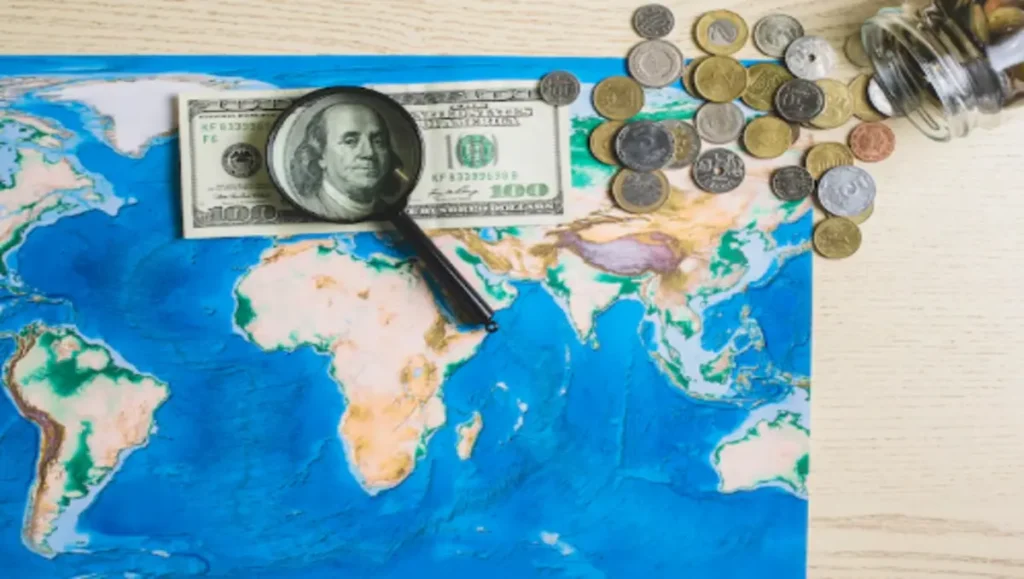Many consumers find it frightening to invest in international funds. After all, there are so many variables to consider—currency risk, economic stability, and many regulations. But once you break it down and have a clear picture, it’s not as complicated as it appears at first.
Whether you’re a seasoned investor or just getting started, understanding what foreign funds are, how they function, and why they might be a good fit for you can help open the door to a whole new world of investment opportunities.
In this blog post, we’ll go over the fundamentals of international funds, discuss the benefits and drawbacks, and explain how they can help diversify your investment portfolio.
What are international funds?
Simply described, foreign funds are investment funds that concentrate on assets outside of their native country. They aggregate funds from several investors and utilize them to purchase stocks, bonds, and other sorts of assets in overseas markets. These funds are managed by professional fund managers that strive to make the most informed investment decisions based on global market trends and opportunities.
For example, if you live in the United States, an international fund may invest in businesses or assets in Europe, Asia, or other parts of the world. The primary purpose is to assist investors in capitalizing on chances for growth in areas other than their own.
Types of International Funds
There are various types of foreign funds, each with a unique focus and goals. Listed below are some of the most common:
1. International Equity Funds.
These funds primarily invest in equities of companies based outside of the investor’s native country. A US-based international equity fund, for example, could invest in Chinese, German, or Brazilian companies. The goal is to capitalize on the growth potential of international companies that are performing well in their own markets.
These monies may be further divided into:
- Developed Markets Funds focus on nations with established and stable economies, such as Japan, the United Kingdom, and France.
- Emerging Markets Funds invest in nations with developing economies, such as India, South Africa, and Indonesia. While they involve more risk, they also have the potential for greater rewards due to rapid expansion.

2. International Bond Funds
Unlike equity funds, which concentrate on stocks, international bond funds invest in bonds issued by foreign governments or firms. These funds let you to invest in the debt of foreign countries or firms and earn interest on those assets.
Bond funds are generally regarded less hazardous than equity funds, although they are nevertheless influenced by interest rates, currency changes, and the economic stability of the country issuing the bonds.
3. Global Funds.
Global funds invest in both foreign and domestic markets, whereas international funds only invest in assets outside of your native country. For example, a global fund may invest in both U.S. stocks and overseas stocks from Europe or Asia. These funds combine local and overseas investments, providing some measure of diversification inside a single fund.
4. Regional Funds.
These funds target certain regions, such as Latin America, Asia-Pacific, and Europe. A regional fund, for example, might only invest in Latin American countries, focusing on economies such as Brazil, Argentina, and Mexico.
Regional funds can give a more concentrated investment strategy by allowing you to concentrate on a certain region of the world that you believe has the greatest growth potential.
Why should you consider international funds?
Now that we’ve discussed the many sorts of international funds, you may be wondering, “Why should I invest in them? “What benefits do they provide?”
Here are some reasons why international funds might be a valuable addition to your portfolio:
1. Diversification.
One of the primary motivations for investing in overseas funds is diversity. By diversifying your investments across countries and regions, you lower the risk that your portfolio will be impacted by a downturn in your home market. If the stock market in the United States is underperforming, you may find that other markets (such as Europe or Asia) are performing better, which can help balance out your overall results.
Diversification means not putting all your eggs in one basket. Even if one region or market experiences difficulties, the others may still be expanding.

2. Exposure to Global Growth
Some of the world’s fastest-growing economies are found outside of established countries such as the United States and Europe. Investing in overseas funds gives you access to these high-growth markets, which may provide higher returns in the long term. For example, emerging economies in Asia and Africa are seeing fast industrialization and urbanization, which has the potential to fuel tremendous growth in the coming years.
3. Currency diversification.
Investing in international funds exposes your portfolio to different currencies. While currency swings may cause instability, they can also create opportunity. For example, if the US dollar falls versus the euro or the yen, international funds invested in those currencies may see an increase in value when converted back to dollars.
4. Mitigate Domestic Economic Risks
No country is exempt from economic downturns. While the United States may be doing well today, there is always the possibility of a recession, political instability, or other difficulties affecting domestic markets. Investing in international funds protects you against the hazards associated with excessive exposure to one country’s economy.
5. Access to foreign markets and sectors.
Some sectors or industries may have a stronger presence in overseas markets than in your home country. Certain industries, such as technology or energy, may be more prominent in countries outside of the United States, and investing in foreign funds allows you to take advantage of these opportunities.
Risks of Investing in International Funds.
While overseas funds have some advantages, they are not without risks. Here are some of the hazards you should be aware of before embarking on overseas investing:
1. Currency Risk.
When you invest in international markets, currency exchange rate fluctuations might affect the value of your investments. If the US dollar appreciates versus the euro, your European investments may lose value when converted to dollars. Currency risk can be unpredictable, adding an extra element of volatility to your investments.
2. Political and Economic Risks
Different countries experience varying levels of political and economic stability. Investing in emerging economies, for example, may expose you to political risks such as regime transitions or instability. In some situations, these factors can have a substantial impact on the performance of the companies in which you’ve invested, as well as your capacity to recover your money.
3. Market Risk.
International markets can be turbulent, particularly in poorer nations where economic situations are unstable. A slump in global markets or in a localized region can reduce the value of your international investments. When investing in international funds, you should expect short-term volatility.
4. Regulatory and legal risks.
Every country has its own set of laws and regulations regarding investments. Some markets may be more severely regulated than others, and there is always the possibility of regulatory changes that will impact your assets. For example, a country may unexpectedly implement limitations on foreign ownership of enterprises, affecting your interests.
How to Select the Right International Fund
Choosing the best foreign fund is determined by your financial objectives, risk tolerance, and investing time horizon. Here are some suggestions to help you make an informed decision:
1. Understand your risk tolerance.
International funds, particularly those concentrated in emerging markets, might be riskier than domestic funds. If you’re okay with more volatility and a long-term investment plan, these funds could be a good fit for you. If you desire stability, however, you should look into funds that focus on developed markets or more conservative investments such as international bonds.
2. Consider your investment horizon.
How long do you intend to hold your investment? If you’re in it for the long run (10 years or more), you can afford to tolerate some of the short-term volatility that comes with overseas markets. However, if you’re hoping for more quick profits, international funds may not be the greatest option.
3. Research the Fund’s Fees.

varying international funds have varying costs. Before you invest, be sure you understand the fund’s expense ratios and management fees. While international funds might provide significant growth potential, additional costs can reduce your returns.
4. Check the Fund’s Holdings and Strategy.
Look at the fund’s underlying assets. Do they fit with your investment strategy? Some foreign funds specialize on specific countries or industries, whereas others are more generally diversified. Make sure the fund’s holdings align with your interests and risk tolerance.
Conclusion
International funds are an excellent method to diversify your portfolio, capitalize on global growth, and gain exposure to other markets. While they carry some dangers, particularly those associated to currency fluctuations and geopolitical instability, they also give possibilities to profit from the expansion of rising economies and businesses that may not be available in your home nation.
read more https://financekhush.com
Investing globally is not something you should hurry into, but it may be a valuable component of your long-term financial plan. By conducting research, understanding the many types of international funds, and being aware of the risks, you may make informed decisions that align with your financial objectives.
Top 10 Frequently Asked Questions about International Funds.
1. What exactly are international funds?
International funds are investment instruments that target assets outside of your home country. These funds aggregate money from many investors to purchase stocks, bonds, and other securities in overseas markets. The idea is to capitalize on global possibilities by investing in international assets. This might range from the IT behemoths of Japan to growing economies like India and Brazil.
2. How might international funds assist diversify my portfolio?
Great question! When you just invest in local assets, you are bound to the performance of a single economy. If the economy has a downturn, your portfolio may suffer. However, international funds diversify your investments over multiple countries, reducing the risk associated with a single market. If one country experiences a crisis, another may be booming, which might assist to balance your risks.
3. Are overseas funds risky?
Yes, but every investment involves risk. International funds, particularly those focusing on emerging economies, are generally more risky than domestic funds. This is due to the fact that political instability, currency volatility, and varying rules can all have an impact on international markets. However, increased risk often means larger returns. It is all about balancing risk and return and matching it to your risk tolerance.
4. What is the difference between international and global funds?
The primary distinction is that international funds invest just in overseas markets, excluding your home country, whereas global funds can invest in both international and local markets. For example, a global fund established in the United States may invest in both domestic and overseas companies, giving investors the best of both worlds.
5. Why should I invest in emerging markets?
Emerging markets such as China, India, and Brazil are among the world’s most rapidly rising economies. Investing in these markets can provide access to stronger growth potential than in more established nations. However, emerging markets can be unpredictable and risky, therefore they are frequently best suited to investors with a longer time horizon and a higher risk tolerance.
6. How do currency swings impact international investment?
Currency fluctuations are a major consideration when investing internationally. If the value of your home currency rises against a foreign currency, the rewards on your investment may fall when converted back into your home currency. Conversely, if your local currency falls, your returns may climb. Currency risk should be considered while investing in overseas markets.
7. What fees are connected with overseas funds?
International funds, like domestic funds, incur fees, primarily in the form of management fees and expenses. Fees for international funds may be slightly higher due to the additional research and management involved. Always review the fund’s charge structure before investing, as large fees can reduce your profits over time. Look for funds with a good combination of performance and cost.
8. Can I invest in overseas funds using my retirement account?
Yes! You can invest in international funds using retirement accounts such as IRAs or 401(k). Many retirement plans provide a selection of mutual funds and exchange-traded funds (ETFs), including ones geared toward international markets. This is a good method to increase global exposure in your retirement portfolio without having to manage individual investments abroad.
9. How can I determine whether an overseas fund is good for me?
The selection is based on your financial goals, time horizon, and risk tolerance. If you want better returns and are willing to take some risks, international funds could be a good option. However, if you are more risk-averse or approaching retirement, you may choose to concentrate on less volatile investments. To identify the best fit, spend time researching other funds, their target areas, and prior performance.
10. How can I select the appropriate overseas fund for my portfolio?
Choosing the correct foreign fund requires an awareness of your investment objectives, risk tolerance, and locations or sectors of interest. Begin by examining the fund’s focus: is it geographical (e.g., Asia or Europe), or does it concentrate on emerging markets? Also, look into the fund’s track record, management team, and expenditure ratio. A well-diversified fund with modest fees and a proven track record is typically a good place to begin.










